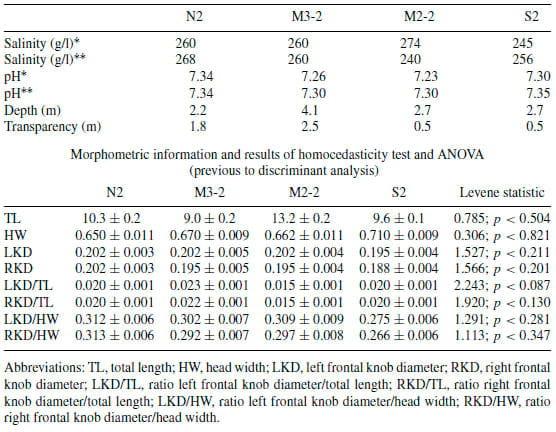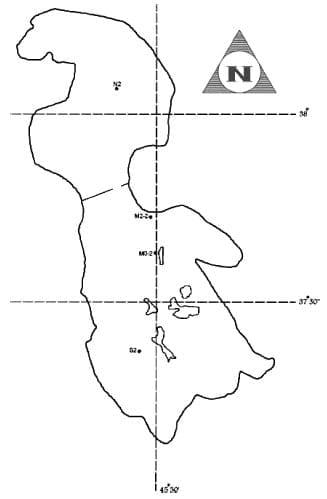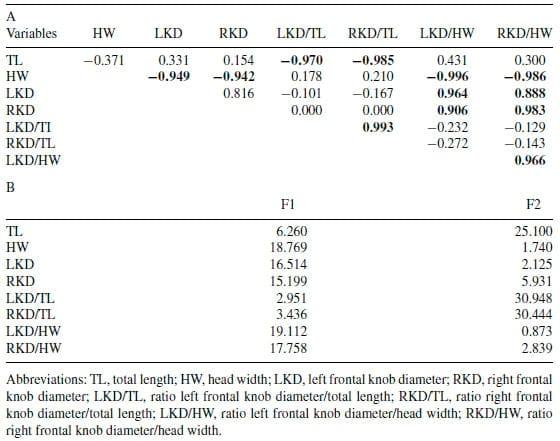INTRODUCTION
The genus Artemia Leach, 1819 is cosmopolitan and includes seven species, with various geographically widespread strains (Triantaphyllidis et al., 1998). The origin of populations can be natural through cyst dispersal by water birds or wind, or artificial through inoculation of cysts in salt works (Sorgeloos et al., 1986). Artemia strains can be sexual, such as in the American and in some European and Asiatic populations, and there are parthenogenetic populations, distributed mainly throughout Asia and Europe (Triantaphyllidis et al., 1998). Artemia has a remarkable genetic variability that can be expressed in various phenotypic characteristics, such as morphometry, growth rate, or molecular composition (Gajardo et al., 1995, 1998, 2004; Triantaphyllidis et al.,1997a, b). Such variations constitute a first step in the geographical isolation of strains, and the allopatry is often associated with strong environmental heterogeneity that consequently generates genetic isolation concurrent with differences in the expression of phenotypes, which may eventually lead to reproductive isolation, i.e., the origin of potentially new species (Gajardo et al., 1995, 1998, 2004; De los Ríos & Zúñiga, 2000).
In part, reproductive isolation is associated with mechanisms relating to reproduction, such as the frontal knobs in Artemia males, two protuberances that are introduced into a pair of cavities located in the posterior zone of the female ovisac, similar to a specific "key-and-lock" mechanism (Wolfe, 1980;Wilson et al., 1993). Considering the importance of reproductive isolation in Artemia the frontal knob can be used for species discrimination (De los Ríos&Zúñiga, 2000). The first comparative study of frontal knob morphometry for Artemia strains mainly involved Chilean and Argentinean populations, and established significant differences between populations of A. franciscana Kellogg, 1906 and A. persimilis Piccinelli & Prosdocimi, 1968 (cf. De los Ríos & Zúñiga, 2000). Also, the descriptions by Mura et al. (1989a, b), Mura (1990), and Mura & Brecciaroli (2004) indicate that American Artemia populations and bisexual species from Asia, including A. urmiana, have subspherical frontal knobs.
The present study was carried out with strains of A. urmiana Günther, 1899, which is a sexual species endemic to Urmia Lake, Iran, a permanent, saline lake. Recently, this lake underwent salinity changes due to climate change and human intervention (Abatzopoulos et al., 2006). The aim of this study is to compare the diameter of the frontal knobs in four samples of A. urmiana, in order to determine possible dissimilarities between the samples.
MATERIAL AND METHODS
Site description. — Urmia Lake is a large, shallow lake (approx. 140 × 80 km area, on average ca. 16 m deep) located in the north of Iran (45?40�N 37? 20�E, fig. 1), it is hypersaline and oligotrophic, and located at 1250 m above sea level. Recently, human intervention has caused alterations in the lake's morphometry, and in that of its surrounding effluent rivers. Four samples of Artemia were collected at different sites, and salinity and pH were recorded. The sites are marked (from north to south), as N2, M2-2, M3-2, and S2, respectively. Adult specimens were collected and fixed with formaldehyde, and 30 male specimens of A. urmiana were selected from each site (Asem et al., 2007). For each specimen, measurements of total body length (TL), and head width (HW) were taken (cf. Amat, 1980; Hontoria & Amat, 1992), as well as the left and right frontal knob diameter (LKD and RKD, respectively) (cf. De los Ríos & Zúñiga, 2000), and of each frontal knob (left and right), the ratios with head width (LKD/HW and RKD/HW) and total length (LKD/TL and RKD/TL), were determined.
Fig. 1. Geographical location of the sites studied in the present paper, in Urmia Lake, Iran: N2,M2-2, M3-2, and S2.
The information available on the frontal knobs was analysed in the following steps: the homogeneity of variances was verified using a Levene test for determining the prerequisite condition for a parametric test (Anderson & Underwood, 1997). Then a Principal Component Analysis (PCA) was applied to determine the most important variables to discriminate the populations studied. All statistical analyses were done with the software Xlstat.
RESULTS
The ecological parameters observed when the wild specimens of Artemia urmiana were collected, invariably indicated hypersaline waters, and in general low differences in pH, salinity, depth, and transparency values for each station sampled (table I). The results revealed variation in the homogeneity of all parameters studied (table I). The results of the correlation matrix denoted significant, direct correlations of LKD/HW with LKD, LKD/HW with RKD, RKD/HW with LKD, RKD/HW with RKD, and RKD/HW with LKD/HW (table II). A significant, inverse relation was observed of LKD/TL with TL, RKD/TL with TL, LKD with HW, RKD with HW, LKD/HW with HW, and RKD/HW with HW (table II). The results of the PCA revealed a contribution of 97.34% of the variables studied, the first axis contributing for 63.45%, and the main contributing factors being HW, LKD, RKD, LKD/HW, and RKD/HW, with a contribution between 15.199 and 19.112% (table II). The second axis contributed for 33.890%, and the main contributing variables were TL with 25.100%, LKD/TL with 30.948%, and RKD/TL with 30.444% (table II). The results of the PCA indicate that the populations studied are markedly different: the N2 population has high values of RKD, LKD, LKD/HW and RKD/LW and a low value of HW; the M3-2 population has high values of RKD/TL and LKD/TL and a low value of TL; the M2-2 has a high value of TL and low values of LKD/TL and RKD/TL; finally, the S2 population has a high value of HW, and low values of RKD, LKD, LKD/HW, and RKD/LW(fig. 2).
DISCUSSION
The results obtained agree with similar results for American brine shrimp species that have a wide range in frontal knob diameters (De los Ríos & Zúñiga, 2000). On this basis, the frontal knobs would provide a powerful tool to study and discriminate Artemia populations, considering the role of these structures in mechanisms of reproductive isolation (De los Ríos & Zúñiga, 2000). If we considerer the results obtained in the present study, the A. urmiana samples show morphological differences (Asem et al., 2007) (table I; fig. 2) that could be explained by the existence of environmental heterogeneity in the habitats of the studied populations (Abatzopoulos et al., 2006). A. urmiana only occurs in Urmia Lake (Abatzopoulos et al., 2006; Baxevanis et al., 2006), and it can coexist there with A. parthenogenetica Bowen & Sterling, 1978 (cf. Abatzopoulos et al., 2006; Agh et al., 2007).
TABLE I. Environmental characteristics for stations sampled in Urmia Lake, morphometric parameters (average ± standard error; in mm), and results of statistical analysis ("p" values lower than 0.05 denote significant differences) for Artemia urmiana Günther

If we considerer that Urmia Lake is a relatively heterogeneous habitat due to its natural conditions and due to human intervention (Abatzopoulos et al., 2006), those conditions could probably be the cause of the variation observed in the morphometric parameters studied as noted in the present study, between the four widely separated sites sampled. The results indicate that the frontal knob diameter as a method to study population heterogeneity and potential reproductive isolation of Artemia populations as suggested by De los Ríos & Zúñiga (2000), can be used for A. urmiana samples, but as a complement to morphological characters, cyst biometry (Abatzopoulos et al., 2006; Asem et al., 2007), and genetic information (Yarmohammadi & Pourkazemi, 2004; Baxevanis et al., 2006).
TABLE II. A, Correlation matrix of parameters of Artemia urmiana Günther morphometry considered in the present study; values in bold denote significant correlations (p < 0.05); and, B, percentages of importance of the morphometric parameters considered in the present study
Fig. 2. Principal Component Analysis of the Artemia urmiana Günther, 1899 populations studied. For explanation see text.
ACKNOWLEDGEMENTS
This study was carried out at Urmia University, Urmia, Iran (Artemia and Aquatic Animals Research Institute). The support of the Research Direction of the Catholic University of Temuco, Temuco, Chile (Funding for Development of Limnology Project DGI-DCA-01), is also gratefully acknowledged.
REFERENCES
ABATZOPOULOS, T., N. AGH, G. VAN STAPPEN, S. M. RAZAVI RUHANI & P. SORGELOOS, 2006. Artemia sites in Iran. Journ. mar. biol. Ass. U.K., 86: 299-307.
AGH, N., T. J. ABATZOPOULOS, I. KAPPAS, G. VAN STAPPEN, S. M. RAZAVI RUHANI & P. SORGELOOS, 2007. Coexistence of sexual and parthenogenetic Artemia populations in Lake Urmia and neighbouring lagoons. Internat. Rev. Hydrobiol., 92: 48-60.
AMAT, F., 1980. Diferenciación y distribución de las poblaciones de Artemia (Crustáceo, Branchiopodo) de España. II. Incidencia de la salinidad ambiental sobre la morfología y desarrollo. Investigación Pesquera, Barcelona, 44: 485-503.
ANDERSON, M. J. & A. J. UNDERWOOD, 1997. Effects of gastropod grazers on recruitment and succession of an estuarine assemblage: a multivariate and univariate approach. Oecologia, 109: 442-453.
ASEM, A., N. RASTEGAR-POUYANI & N. AGH, 2007. Biometrical study of Artemia urmiana (Anostraca: Artemiidae) cysts harvested from Lake Urmia (West Azerbaijan, Iran). Turkish Journ. Zool., 31: 171-180.
BAXEVANIS, A. D., I. KAPPAS & T. J. ABATZOPOULOS, 2006. Molecular phylogenetics and asexuality in the brine shrimp Artemia. Mol. Phylogenet. Evol., 40: 724-738.
DE LOS RÍOS, P., 2005. Richness and distribution of zooplanktonic crustacean species in Chilean Andes mountains and southern Patagonia shallow ponds. Polish Journ. environm. Stud., 14: 817-822.
DE LOS RÍOS, P. & O. ZÚÑIGA, 2000. Comparación biométrica del lóbulo frontal en poblaciones americanas de Artemia (Anostraca, Artemiidae). Rev. Chilena Hist. nat., 73: 31-38.
GAJARDO, G., N. COLIHUEQUE, M. PARRAGUEZ & P. SORGELOOS, 1998. International study on Artemia. VIII. Morphologic differentiation and reproductive isolation of Artemia populations from South America. Int. Journ. Salt Lake Res., 7: 133-151.
GAJARDO, G., M. DA CONCEICAO, L. WEBER & J. A. BEARDMORE, 1995. Genetic variability and interpopulational differentiation of Artemia strains of South America. Hydrobiologia, 302: 21-29.
GAJARDO, G., J. CRESPO, A. TRIANTAPHYLLIDIS, A. THIKA, A. D. BAXENAVIS, I. KAPPAS & T. J. ABATZOPOULOS, 2004. Species identification of Chilean Artemia populations based on mitochondrial DNA RFLP analysis. Journ. Biogeogr., 31: 547-555.
HONTORIA, F. & F. AMAT, 1992. Morphological characterization of adult Artemia (Crustacea, Branchiopoda, Anostraca). Journ. Plankt. Res., 14: 1461-1471.
MURA, G., 1990. Artemia salina (Linnaeus, 1758) from Lymington, England: frontal knob morphology by scanning electron microscopy. Journ. Crust. Biol., 10: 364-368.
MURA, G. & B. BRECCIAROLI, 2004. Use of morphological characters for species separation within the genus Artemia (Crustacea, Branchiopoda). Hydrobiologia, 520: 179-188.
MURA, G., L. DEL CALDO & A. FANFANI, 1989a. Sibling species of Artemia: a light and electron microscopic survey of the frontal knobs. Part I. Journ. Crust. Biol., 9: 414-419. ——,— —&——, 1989b. Sibling species of Artemia: a light and electron microscopic survey of the frontal knobs. Part II. Journ. Crust. Biol., 9: 420-424.
SORGELOOS, P., P. LAVENS, P. LEGER, W. TACKAERT & D. VERSICHELE, 1986. Manual for the culture and use of brine shrimp Artemia in aquaculture: 1-319. (Universa Press, Wetteren).
TRIANTAPHYLLIDIS, G. V., T. J. ABATZOPOULOS & P. SORGELOOS, 1998. A review of the biogeography of the genus Artemia (Crustacea, Anostraca). Journ. Biogeog., 25: 213-226.
TRIANTAPHYLLIDIS, G. V., G. R. J. CRIEL, T. J. ABATZOPOULOS & P. SORGELOOS, 1997 (cf. a). International study of Artemia LIII. Morphological study of Artemia with emphasis to Old World strains. I. Bisexual populations. Hydrobiologia, 357: 139-153.
TRIANTAPHYLLIDIS, G. V., G. R. J. CRIEL, T. J. ABATZOPOULOS, K. M. THOMAS, J. PELEMAN, J. A. BEARDMORE & P. SORGELOOS, 1997 (cf. b). International study on Artemia LVII. Morphological and molecular characters suggest conspecifity of all bisexual European and North African Artemia populations. Mar. Biol., Berlin, 129: 477-487.
WILSON, R., O. ZUÑIGA & R. RAMOS, 1993. Estudio comparativo de la morfología del lóbulo frontal de cuatro poblaciones chilenas de Artemia sp. con microscopía electrónica de barrido. Est. Oceanol., 12: 13-16.
WOLFE, A. F., 1980. A light and electron microscopic study of the frontal knob of Artemia (Crustacea, Branchiopoda). In: G. PERSOONE, P. SORGELOOS, O. ROELS & E. JASPERS (eds.), Artemia: research and its applications, 1,Morphology, genetics, radiobiology, toxicology: 117- 130. (Universa Press, Wetteren).
YARMOHAMMADI, M. & M. POURKAZEMI, 2004. Cytogenetic study of Artemia from Urmiah, Maharloo and Incheborun lakes. Hydrobiologia, 529: 99-104.








